Key features of SCS
SCS was created for both professional and hobbyist simulators alike. With SCS it becomes incredibly easy to create simulator-independant software. It is also a solution for connecting replica and real avionic components to your simulator.

CAN Aerospace
CAN Aerospace is a protocol riding on top of the über-reliable CAN bus.
It is widely used in professional and military flight simulators.
CAN and CAN Aerospace are open standards. You can learn more about CAN Aerospace at wikipedia and at the official website. The protcol is extremely lightweight and user-extensible.
Network
SCS takes CAN Aerospace to the network level. The best facility to connect your hardware and simulator is the network: No need to install drivers, no fuss with USB hubs, simply plug it to your router and go flying!
And the best is: The network does not care for you operating system. Whether you are running FSX on Windows, X-Plane on Mac, or Flightgear on Linux, SCS will connect your hardware and software using the same normalized protocol.
No Config
Wouldn't it be smart if your simulator could feed any number of clients without knowing them? Exactly this is achieved through the clever use of network technology. Your clients subscribe to flight data provided through SCS, which will then handle the transmission. For the simulator it looks as if it is feeding only one client, which effectively could be 100 hardware and software modules.
Software
Software using SCS can be written in C++ or Java. For both languages a SDK and example applications are avialable. The SDKs are free for commercial and open-source software applications.
Hardware
Hardware clients can either connect to the network or CAN bus. The CAN bus is routed to the network via a gateway. Flightpanels.com offers a variety of CAN Aerospace devices including radio stack, instrument drivers and CAN gateways.
